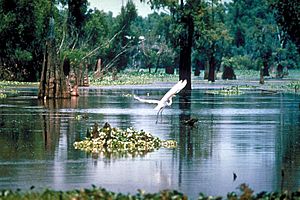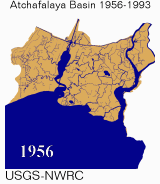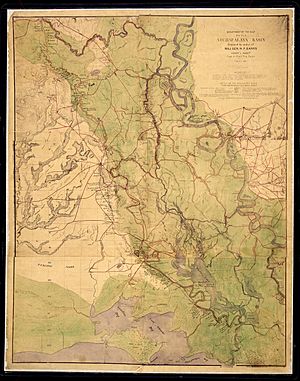Atchafalaya Basin facts for kids
The Atchafalaya Basin, also known as the Atchafalaya Swamp, is the largest wetland and swamp in the United States. It's found in south central Louisiana. This huge area is a mix of wetlands and a river delta where the Atchafalaya River meets the Gulf of Mexico. The river flows from near Simmesport in the north, through parts of eight parishes, all the way to the Morgan City area in the south.
The Atchafalaya Basin is special because its delta system is still growing. This means new land is forming, and its wetlands are quite stable. About 70% of the basin is forest, and 30% is marsh and open water. It has the largest connected area of forested wetlands left in the lower Mississippi River valley. It also holds the biggest block of floodplain forest in the United States. This forest is famous for its cypress-tupelo swamps. At 260,000 acres (110,000 ha), it's the largest connected area of coastal cypress trees in the country.
Contents
What the Atchafalaya Basin Looks Like
The Atchafalaya Basin is full of bayous, bald cypress swamps, and marshes. As you move closer to the Gulf of Mexico, the water becomes brackish (a mix of fresh and salt water). Eventually, it turns into Spartina grass marshes where the Atchafalaya River flows into the Gulf.
This area often experiences long periods of deep flooding, so not many people live there. The basin is about 20 miles (32 km) wide from east to west and 150 miles (240 km) long. It covers about 1,400,000 acres (5,700 km2), making it the largest wetland in the United States. This includes the swamps outside the levees that were once connected to the main basin.
The basin is home to many important forests, swamps, bayous, and lakes. Thousands of acres of forest and farmland here are home to the Louisiana black bear (Ursus americanus luteolus). This bear has been on the United States Fish and Wildlife Service threatened list since 1992.
Few roads cross the basin, and those that do are built on top of levees. Interstate 10 crosses the basin on a long, elevated bridge. This Atchafalaya Basin Bridge is 18.2-mile (29.3 km) long.
The Atchafalaya National Wildlife Refuge was created in 1984. Its goal is to help plants and animals, especially endangered ones, waterfowl, migratory birds, and alligators.
How the Basin Was Formed and Floods
The Atchafalaya Basin has always been connected to the Mississippi River. The way the basin looks today is directly because of this relationship. Over time, the Mississippi River has changed its path, building up new land in south Louisiana. The Atchafalaya Basin was part of these land-building processes. Today, new land is still forming at the mouth of the Atchafalaya River.
The basin naturally filled with sediment (dirt and sand) carried by the river. This process sped up when flood control levees were built in the 1940s. These levees directed sediment into a smaller area, about one-third the size of the original basin.
The Atchafalaya River was once a low-lying area between different paths of the Mississippi River. The natural banks of the Mississippi River on the east and old river paths (now Bayou Teche) on the west define the Atchafalaya Basin. Human-made levees also surround the central basin. These levees are designed to hold and guide floodwaters from the Mississippi River south towards Morgan City and the Gulf of Mexico.
In the mid-1800s, people made changes to the river. They removed a large log jam and dredged the channel. This permanently connected the Atchafalaya River to the Mississippi River. Over time, the Mississippi started sending more and more water into the shorter, steeper Atchafalaya path. To control this, the Old River Control Structure was built in 1963. By law, about 30% of the water from the Mississippi, Red, and Black rivers is now sent into the Atchafalaya. This means about 25% of the Mississippi River's flow goes down the Atchafalaya.
When there are very big floods, the United States Army Corps of Engineers can open the Morganza Spillway. This helps reduce pressure on the levees along the Mississippi River. For example, in 2011, the Morganza Spillway was opened for the first time since 1973. This sent floodwaters into the Atchafalaya Basin, protecting cities like New Orleans.
Changes in the Swamps
Controlling the floods of the Atchafalaya and Mississippi rivers has become a big topic. The USGS reports that the Mississippi River delta salt marshes are shrinking by about 29 square miles per year (2.4 km2/Ms). However, the Atchafalaya River Deltas are the only places along the Louisiana Gulf Coast where new land is actually growing.
In the early 1900s, the Atchafalaya River Basin was chosen as a place to send floodwaters from the Mississippi River. To do this without flooding farms and towns, protective levees were built. These levees separated the Atchafalaya Basin Floodway from much of the old swamp. A main channel was also dug through existing waterways and some swamp forests. This connected the Atchafalaya Basin to a large river full of sediment.
From 1850 to 1950, the amount of open water in the basin decreased. It went from 190 to 110 square miles (490 to 290 km2). By 2005, it had shrunk further to 73 square miles (190 km2). This change happened because sediment from the river filled in open water areas.
During the 1960s to 1980s, oil and gas companies started exploring and drilling a lot in Louisiana. They dug many large canals for access and pipelines through deep swamp areas and across bayous. In some parts of the basin, there are 1.2 miles (2 km) or more of these human-made canals for every 0.62 miles (1 km) of natural bayou. These large channels (100–165 feet or 30–50 metres wide and 5–10 feet or 2–3 metres deep) changed how water flows in the swamps. Areas that were once protected from sediment now got it directly from the river and filled up quickly.
The USGS has measured how fast sediment builds up. It can be as much as 10 inches (30 cm) per year where these canals meet open water. On nearby floodplains, it's about 1.6 inches (4 cm) per year. In some places, natural bayous have even filled in because the water started flowing into the new access canals instead.
The dirt dug out from these canals was piled up next to them. This also blocked the natural flow of water across the floodplain.
The Bayou Chene Community
From 1830 to 1953, a community called Bayou Chene was a busy center for logging, hunting, trapping, and fishing. It was right in the middle of the Atchafalaya Basin. Today, Bayou Chene is buried under at least twelve feet of mud. It's one of several towns that were abandoned in the basin.
The first people to live in the Bayou Chene area were the native Chitimacha tribe. Several important Chitimacha villages were located around Bayou Chene. One of the first written descriptions of the area came from a French explorer, C.C. Robin, in 1803. He wrote about the beautiful lake surrounded by tall trees.
By 1841, about fifteen to twenty families were farming along "Oak Bayou," or Bayou Chene. The population grew quickly. By the 1870s, most people living there worked in logging. They cut down bald cypress, tupelo, and other trees in the basin.
In the early 1900s, Bayou Chene was the main hub for the basin's cypress and fur industries. Many of the 1,000 full-time fishermen who worked in the swamp lived there. Gwen Roland, whose family lived in the region, described how the community depended on the basin's waters for everything, even transportation.
The Great Mississippi Flood of 1927 almost destroyed the community. Floodwaters rose seven feet above the natural banks and covered Bayou Chene for weeks. A local story says a village goat survived in the Methodist Church by eating hymnals and wallpaper!
The Great Depression was hard on the people of Bayou Chene. However, many former residents remember the large flood control projects by the United States Army Corps of Engineers fondly. These projects provided jobs during that difficult time. Because of the 1927 flood, the entire Atchafalaya Basin was named an official floodway. A series of human-made levees were built, which forever changed how floods affected the area. More flooding in 1937 made many residents move their homes to higher ground. But even this wasn't enough to protect the community from yearly floods.
After years of rising waters, the community ended when the United States Post Office at Bayou Chene closed in 1952. Most of Bayou Chene's former residents moved to towns on the edge of the basin, like New Iberia, St. Martinville, and Breaux Bridge. Today, very little remains of the swamp community, which is now buried under the muddy waters of the Atchafalaya.
Gallery
See also
 In Spanish: Cuenca Atchafalaya para niños
In Spanish: Cuenca Atchafalaya para niños






